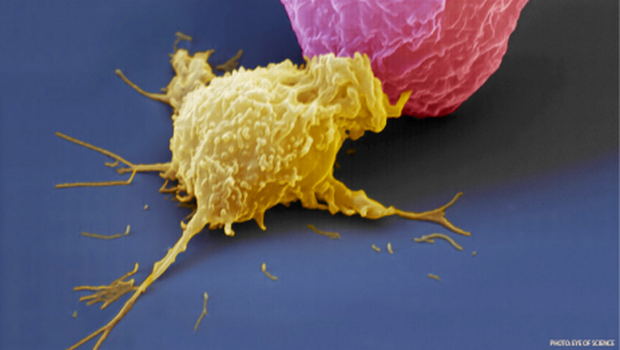Scientists Discover 'Invisibility Cloak' for Immune Cells
The various cells in the immune system have to protect themselves from one another so that they don’t kill each other. Immune biologist Annette Oxenius and her team from ETH Zurich have now discovered a previously unknown mechanism that immune cells use to protect themselves from friendly fire.


Natural killer cells (yellow) identifies and kills cancer cells (pink) or virus infected cells before they wreak havoc on the organism. Photo credit: Eye of Science
The various cells in the immune system have to protect themselves from one another so that they don’t kill each other. Immune biologist Annette Oxenius and her team from ETH Zurich have now discovered a previously unknown mechanism that immune cells use to protect themselves from friendly fire.
The human immune system is very complex. A large number of different cells with various functions ensure that invading microorganisms such as viruses or bacteria can quickly be rendered innocuous and the entire organism stays healthy.
The immune system also includes natural killer cells (NK cells), which recognize and eliminate tumor or virus-infected cells. NK cells therefore combat the body’s own stressed cells to prevent them from becoming a potential hazard. However, this bears its risks. Other immune cells, the specific killer cells, which are also known as CD8+ T cells and multiply prodigiously and mature in response to an infection, can also exhibit stress symptoms and thereby potentially end up on the NK cells’ hit list.
Researchers from immune biology professor Annette Oxenius’s group have now discovered what keeps NK cells from killing off their “colleagues from the other department” of the immune system: healthy CD8+ cells are able to detect the immune messenger substance type 1 interferon, which binds to specific receptors on the surface of these immune cells and thereby conceals their stress. In other words, it acts as a camouflage cloak that renders them invisible to the NK cells. If the T cells lack the docking site for type 1 interferon, however, they are hunted down by the NK cells and exterminated.
The researchers discovered this using mice which they infected with two model viruses. If the animals’ CD8+ T cells lacked these interferon receptors, not only did the NK cells eliminate the virus-infected cells, but also the immune cells that were supposed take action, thereby weakening the antiviral immune response.
The researchers studied exactly how the mechanism works using mice whose CD8+ T cells did not have any type 1 interferon receptors and in whom they also depleted the NK cells. If no natural killers were present, the T cells multiplied, matured and developed despite the lack of interferon detection. Moreover, the ETH-Zurich immune biologists discovered that these sensorless T cells increasingly formed an “identification tag” on their surfaces, which triggered the lethal effect of the NK cells as soon as they came into contact with them. Thus, the expression of this "stress tag" is suppressed by interferon binding to and signalling via the interferon receptors on T cells. If this signalling is prevented because the receptor is lacking, the cell expresses large amounts of these stress molecules.
So far, it is unclear whether the same mechanism also exists in humans. However, the basic processes that the human immune system uses to protect its T cells against an attack from natural killer cells might well be comparable. On the one hand, the researchers now understand which mechanisms the stressed T cells need to protect themselves against NK cells. On the other hand, this insight enables new hypotheses to be formulated. For instance, it is conceivable that T cells activated in the absence of type 1 interferon reveal themselves as being “stressed” and are thus killed off. Such situations could arise during the activation of autoimmune reactive T cells, for instance, which normally occurs in absence of high concentrations of type 1 interferon. Oxenius and her team will test these exciting hypotheses with great interest over the next few years.
Reference: Crouse J, Bedenikovic G, Wiesel M, Ibberson M, Xenarios I, Von Laer D, Kalinke U, Vivier E, Jonjic S, Oxenius A. Type I Interferons Protect T Cells against NK Cell Attack Mediated by the Activating Receptor NCR1. Immunity. 2014 Jun 19;40(6):961-73. doi: 10.1016/j.immuni.2014.05.003 . Epub 2014 Jun 5.
Source: ETH Zurich
IDEA in Action: A Strategic Approach to Contamination Control
January 14th 2025Adopting IDEA—identify, define, explain, apply—streamlines contamination control. Infection control professionals can mitigate risks through prevention, intervention, and training, ensuring safer health care environments and reducing frequent contamination challenges.
Balancing Freedom and Safety: When Public Health Mandates Are Necessary
January 9th 2025Public health mandates, such as lockdowns, masking, and vaccination, balance liberty and safety, ensuring critical protections during pandemics like COVID-19 while fostering long-term survival through science.
Long-Term Chronicles: Infection Surveillance Guidance in Long-Term Care Facilities
January 8th 2025Antibiotic stewardship in long-term care facilities relies on McGeer and Loeb criteria to guide infection surveillance and appropriate prescribing, ensuring better outcomes for residents and reducing resistance.
Considering Avian Flu: World Health Organization Expert Warns Against Raw Milk
January 6th 2025Drinking raw milk poses risks of disease transmission, especially with H5N1 outbreaks. Expert Richard J. Webby, PhD, advises against raw cow or goat milk consumption due to its unpredictable and significant risks.